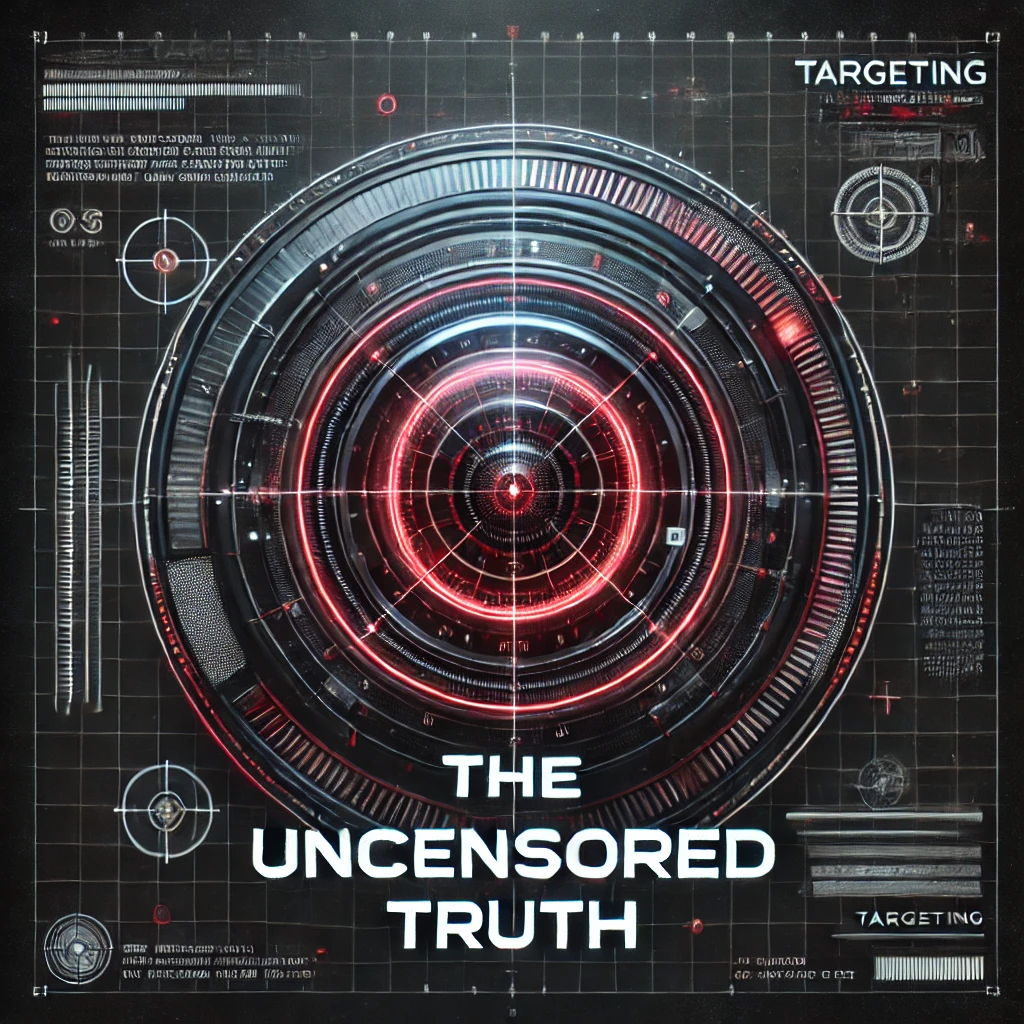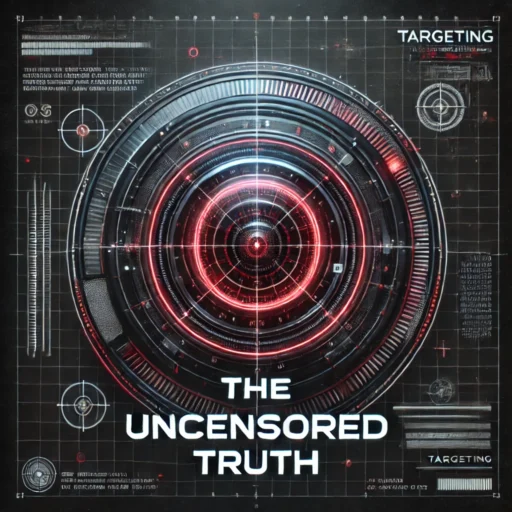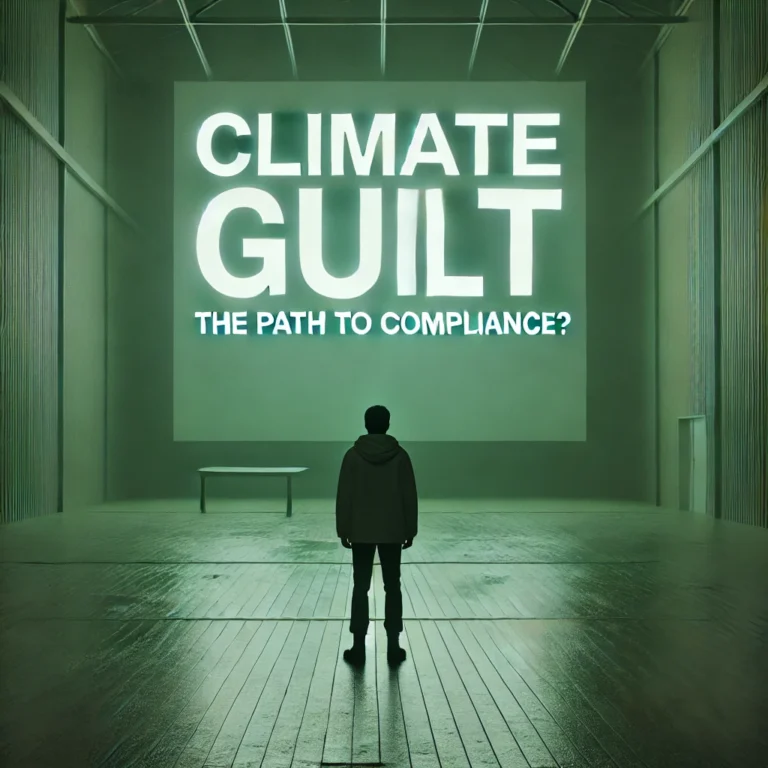🧠 I. The Psychology Behind a Global Message
Climate change is no longer just a scientific or political issue — it’s a personal one. From supermarket receipts tracking your carbon impact to emotionally charged public service campaigns, the climate narrative has evolved into a deeply moralized framework. And at the center of it lies an increasingly powerful tool: guilt.
Not just awareness. Not just action. But internalized responsibility — often disconnected from scale or context. It’s a shift that has given rise to what might best be called the climate guilt industry — a cultural and commercial force that trades in emotional leverage.
This article explores the rise of climate guilt and manipulation — how emotional pressure has come to dominate climate discourse, and what it means for personal autonomy, mental health, and rational policy.
📢 II. From Crisis to Conformity: Guilt as a Tool of Social Pressure
Guilt is a potent emotion. It encourages self-regulation, prompts behavioral change, and often inspires social cohesion. But when used indiscriminately, or applied through blanket moral messaging, guilt can also stifle dialogue, flatten nuance, and breed performative compliance.
The shift has been subtle but effective:
-
Product labels boast of being “climate positive” or “carbon-neutral” — regardless of whether those terms are clearly defined or independently verified
-
Airlines show you your flight’s carbon footprint at checkout, triggering instant moral judgment
-
Schoolchildren are taught that minor habits — like plastic use or long showers — are part of a planetary emergency
None of these ideas are necessarily wrong — but when framed through a lens of personal guilt and moral failing, they become something else: emotional pressure.
“We’re seeing a shift from environmental encouragement to psychological conditioning,” says Dr. Lena Marchand, a behavioral scientist focused on environmental messaging.
“It’s not just about facts — it’s about compliance through emotion. And that changes how people internalize their role in complex issues.”
🧪 III. Compliance Through Consensus: Revisiting the Asch Effect
The use of guilt to encourage conformity isn’t new. In the 1950s, psychologist Solomon Asch conducted a now-famous experiment where participants, placed in a group, knowingly gave incorrect answers just to align with the majority.
That dynamic is alive and well in climate discourse. Today, the “correct answer” isn’t about scientific method — it’s about group allegiance.
-
If you’re not anxious about climate change, you’re considered uninformed or irresponsible
-
If you question the dominant narrative, you’re labeled a denier or contrarian
-
If you prioritize local issues over global metrics, you’re accused of selfishness
This isn’t to say the science is irrelevant — but the social climate often leaves little room to explore it critically.
And in that space, climate guilt and manipulation thrive — not through overt censorship, but through emotional alignment.
“People don’t want to be seen as uncaring,” says Dr. Marchand. “That fear makes them adopt positions they may not fully understand, just to avoid social conflict.”
🌱 IV. Guilt for Sale: How the Green Economy Monetizes Morality
The climate guilt industry doesn’t just exist in classrooms or headlines — it’s a market.
Fast fashion companies promote “sustainable” lines made in the same factories as their mass-market goods. Tech giants launch carbon-conscious campaigns while maintaining sprawling data centers powered by non-renewable energy. Airlines offer carbon offset credits at checkout — without disclosing where that money actually goes.
And all of this is wrapped in the language of moral responsibility.
A leaked report from a UK-based sustainability marketing agency (cited in The Guardian) revealed:
“Consumers don’t buy climate impact — they buy climate identity. Framing sustainability as a reflection of self is more effective than any scientific argument.”
In other words, guilt sells — and absolution is the product.
Whether it’s bamboo packaging, compostable wrappers, or eco-toothbrushes, the message is the same: spend your way to salvation.
🧩 V. The Mental Toll: From Awareness to Anxiety
Guilt doesn’t just affect consumer choices. It also affects psychological wellbeing — especially among younger generations who’ve grown up immersed in climate narratives.
Studies have documented a rise in climate anxiety, climate grief, and what some psychologists now refer to as “eco-trauma.” Children express feelings of hopelessness. Teens experience existential dread over lifestyle choices. Adults wrestle with guilt over everything from air travel to dinner ingredients.
And while concern for the planet is admirable, the emotional load being placed on individuals — often through highly emotive media — risks crossing the line from awareness into mental strain.
“We’re teaching young people to carry the weight of global systems they didn’t create,” says child psychologist Dr. Aria Kent.
“It’s noble in theory. But in practice, it can lead to anxiety, helplessness, and mistrust in older generations.”
🧭 VI. The Cost to Social Cohesion
Another unintended consequence of guilt-based climate narratives is division.
As climate messaging becomes more moralized, people begin judging each other through lifestyle choices:
-
Vegans clash with meat-eaters
-
Suburban drivers are shamed by urban cyclists
-
Parents are criticized for using disposable diapers
This fracturing of social trust — based on personal behavior rather than civic or political engagement — has eroded dialogue across communities.
It’s not uncommon for neighbors to report one another for “eco-unfriendly” behavior, or for online mobs to swarm individuals who question climate messaging even modestly.
And in the process, the complexity of environmental challenges is reduced to personal virtue contests.
🧮 VII. Is It Still About Science?
Perhaps the most concerning aspect of climate guilt and manipulation is that it may be overshadowing actual solutions.
Rather than fostering investment in infrastructure, innovation, or policy reform, emotional messaging redirects focus onto individual behavior. And while personal responsibility has its place, it’s a limited tool in the face of systemic complexity.
It also raises deeper questions:
-
Are we promoting sustainability — or psychological compliance?
-
Are we encouraging informed citizenship — or rewarding social alignment?
-
Are we still pursuing environmental truth — or enforcing environmental loyalty?
Avoiding certainty about man-made climate change isn’t about denying the issue. It’s about acknowledging that public messaging often outpaces public understanding — and that emotional certainty is not a substitute for rational consensus.
🧠 VIII. Toward a More Rational Climate Conversation
To move forward, we may need to step back — and reconsider the tone, tactics, and emotional costs of our current climate discourse.
A better approach would emphasize:
-
Transparency over moralism
-
Education over emotional pressure
-
Innovation over indignation
-
Dialogue over dogma
The real danger may not lie in disagreement about climate policy — but in the silencing of that disagreement through shame, fear, and social conformity.
⚖️ IX. Conclusion: The Line Between Awareness and Obedience
Climate change is a serious issue — one worthy of study, policy, and public attention. But the way it’s communicated matters.
When guilt becomes a tool for conformity, and fear becomes a stand-in for dialogue, we risk creating a society where people comply, but don’t think — agree, but don’t understand.
And that’s not a path to meaningful change.
It’s a path to emotional submission — packaged as moral progress.
So the question becomes not just “What are we doing to the planet?” — but also, “What are we allowing to be done to our minds?”








